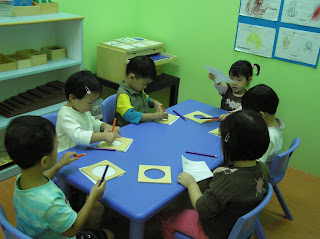"Students must learn mathematics with understanding, actively building new knowledge from experience and prior knowledge. (NCTM, 2000, p.20)
The learning principle summarizes the six lessons that I had in class. In my years of learning, Mathematics was my favourite subject because it was easy to get good grades with lots of practices; not because I understood the concepts behind it.
I looked forward to attend every class; as I have learned and understood Mathematics in a different light. This time, I know why I am learning Mathematics, as I was LEARNING BY DOING! The practical knowledge in class, coupled with the knowledge acquired from the textbook, prompted me to reflect on my teaching practices.

In the preschool years, we followed Jerome Bruner's Concrete-Pictorial-Abstract (CPA) approach for teaching of concepts. We have been teaching the concepts according to the curriculum planned, but, did we manage to 'convince' the children that learning Mathematics is fun and magical?
 Children, as well as teachers, learn by inqury, communicating with their friends, reflecting, doing, and collaborating. As teachers, it is our responsibilty to provide appropriate learning materials when we are teaching new concepts, and importantly, we must design activities with variations to strengthen children's learning. Zoltan P. Dienes's Mathematical Variability Principle suggests that the "generalization of a mathematical concept is enhanced when variablesw irrelevant to that concept are systematically varied while keeping the relevant variables constant" (Post, 1988).
Children, as well as teachers, learn by inqury, communicating with their friends, reflecting, doing, and collaborating. As teachers, it is our responsibilty to provide appropriate learning materials when we are teaching new concepts, and importantly, we must design activities with variations to strengthen children's learning. Zoltan P. Dienes's Mathematical Variability Principle suggests that the "generalization of a mathematical concept is enhanced when variablesw irrelevant to that concept are systematically varied while keeping the relevant variables constant" (Post, 1988).The activities in the class all geared toward getting us to understand number sense, visualisation and patterning! Through the activities, I am more careful with details; trying to find a relationship or pattern among numbers.
My school will be celebrating Children's Day tomorrow, and I will be performing magic using "spelling number" and "dice trick" learned in lesson 1. I want to excite the children and arouse their curiosity minds, in all my future Mathematics classes!
And yes... we must be meticulous in the Mathematical terms that we used in class. Similar is DEFINITELY not the same as identical!
Reference:
Post, T. (1988). Some notes on the nature of mathematics learning. In T. Post (Ed.), Teaching Mathematics in Grades K-8: Research Based Methods (pp. 1-19). Boston: Allyn & Bacon. Retrieved September 29, 2010, from http://www.cehd.umn.edu/rationalnumberproject/88_9.html
No comments:
Post a Comment